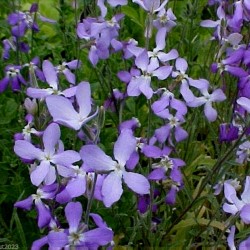Menu
-
Menuالعدمة
- Home
-
التصنيفات
-
-
التصنيفات
-
بذور الخضروات
-
أصناف حسب البلد
- أصناف من أرمينيا
- أصناف من البوسنة والهرسك
- أصناف من كرواتيا
- أصناف من فرنسا
- أصناف من ألمانيا
- أصناف من اليونان
- أصناف من المجر
- أصناف من الهند
- أصناف من إيطاليا
- أصناف من اليابان
- أصناف من شمال مقدونيا
- أصناف من بيرو
- أصناف من روسيا
- أصناف من صربيا
- أصناف من سلوفينيا
- أصناف من اسبانيا
- أصناف من تايلاند
- أصناف من تركيا
- أصناف من الولايات المتحدة الأمريكية
- بذور الطماطم
- بذور الذرة
- عائلة القرع
- الفول الأسرة
- بذور الخيار
- بذور الفلفل
- عائلة الجزرة
- عائلة البصل
- بذور الخس
- عائلة البطاطس
- عائلة الملفوف
- بذور الفجل
- عائلة الشمندر
- بذور البطيخ
- بذور بطيخ
- بذور القرنبيط
- عائلة عباد الشمس
-
أصناف حسب البلد
- بذور الفاكهة
- بذور الفلفل الحار
- بذور عشبة طبية
- تسلق بذور النباتات
- الأشجار - بذور بونساي
- بذور النخيل
- بذور الأعشاب الزينة
- بذور التبغ
-
بذور الخضروات
-
-
-
-
- منتجات جديدة
- التسليم - الدفع
- انشئ حساب
- FAQ
- الصفحة الرئيسية
-
- حزم كبيرة من البذور
- بذور النباتات العملاقة
- بذور الخضروات
- أصناف حسب البلد
- أصناف من أرمينيا
- أصناف من البوسنة والهرسك
- أصناف من كرواتيا
- أصناف من فرنسا
- أصناف من ألمانيا
- أصناف من اليونان
- أصناف من المجر
- أصناف من الهند
- أصناف من إيطاليا
- أصناف من اليابان
- أصناف من شمال مقدونيا
- أصناف من بيرو
- أصناف من روسيا
- أصناف من صربيا
- أصناف من سلوفينيا
- أصناف من اسبانيا
- أصناف من تايلاند
- أصناف من تركيا
- أصناف من الولايات المتحدة الأمريكية
- بذور الطماطم
- بذور الذرة
- عائلة القرع
- الفول الأسرة
- بذور الخيار
- بذور الفلفل
- عائلة الجزرة
- عائلة البصل
- بذور الخس
- عائلة البطاطس
- عائلة الملفوف
- بذور الفجل
- عائلة الشمندر
- بذور البطيخ
- بذور بطيخ
- بذور القرنبيط
- عائلة عباد الشمس
- أصناف حسب البلد
- بذور الفاكهة
- بذور الفلفل الحار
- بذور عشبة طبية
- تسلق بذور النباتات
- الأشجار - بذور بونساي
- بذور الموز
- بذور النخيل
- بذور الأعشاب الزينة
- بذور التبغ
- بذور زهرة
- بذور الصبار
- بذور النباتات المائية
- تعليمات البذر
- قوالب الفاكهة والخضروات
- فطر الفطر
- المصابيح النباتية
- بذور الخيزران
- نباتات الأيورفيدا
- F1 hybrid seeds
- التعبئة والتغليف والاشياء
- نباتات مقاومة للبرد
- منتجات العناية النباتية
- التوابل العضوية
- التسليم - الدفع
- لا دفع باي بال وبطاقة X
Last Product Reviews
Out of the two seeds, one germinated and the other one was dead and floatin...
By
 Riikka H on 07/03/2024
Riikka H on 07/03/2024
Verified Purchase
الأكثر مبيعاً
يوجد 1308 منتجا.
عرض 1261-1275 من 1308 منتجات
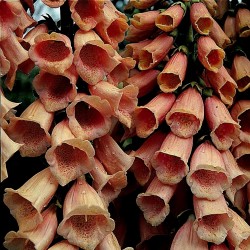
Foxglove Suttons Apricot Seeds
السعر
1.25 €
(SKU: F 26)
Seeds Gallery EU,
5/
5
<div id="idTab1" class="rte">
<h2><span style="font-size:14pt;"><strong>Foxglove Suttons Apricot Seeds (Digitalis Purpurea)</strong></span></h2>
<h2><span style="color:#ff0000;font-size:14pt;"><strong>Price for Package of 20 seeds.</strong></span></h2>
<div>Description: <span style="line-height:1.5em;">An outstanding introduction producing large spikes of a lovely shade of Apricot. A most unusual and sought after colour. Excellent for the border in sun or part shade, and very useful as a cut flower. Flowers early summer. Height 1.3-1.5m (4-5ft). </span><span style="line-height:1.5em;">Sowing Instructions. </span><span style="line-height:1.5em;">Sow in late spring/early summer outdoors in a well prepared seed bed. Sow the seeds very thinly 1.5mm (1/16in) drills 30cm ( 12in) apart, keep the soil damp until germination takes place and thin out the seedlings to 15cm (6in) apart when large enough to handle. </span><span style="line-height:1.5em;">Growing Instructions.</span><span style="line-height:1.5em;">Transplant 60cm (24in) apart into flowering site in the autumn for flowering the following year.</span></div>
<div>
<div>Hardy Biennial</div>
<div>Flowers in : Mid Summer</div>
<div>Germination : Easy</div>
<div>Aftercare : Easy</div>
<div>Ideal for : Borders, Cottage Gardens</div>
<div>Height : 5 feet</div>
</div>
</div>
F 26

- على الإنترنت فقط!
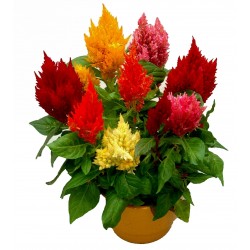
Celosia argentea Seeds Mix
السعر
1.95 €
(SKU: F 31)
Seeds Gallery EU,
5/
5
<div id="idTab1" class="rte">
<h2><span style="font-size: 14pt;"><strong>Celosia argentea Seeds Mix</strong></span></h2>
<h3><span style="color: #ff0000; font-size: 14pt;"><strong>Price for Package of 50 seeds.</strong></span></h3>
<div><span style="font-size: 10pt;">Is a tender annual that is often grown in gardens. It is propagated by seeds. The seeds are extremely small, up to 43,000 seeds per ounce. <span style="line-height: 1.5em;">The Century cultivars are usually taller (1–2 feet), and are bright red, yellow, orange, or pink. The Kimono cultivars are generally smaller (4 inches - 1 foot), and have more muted colors, though similar to the Century cultivars. Other colors, such as white, burgundy, orange-red, etc., can be found. Certain varieties will grow to 3–4 feet in height.</span></span></div>
</div>
F 31

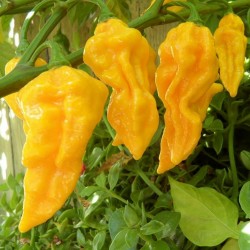
Habanero Devil's Tongue...
السعر
2.15 €
(SKU: C 77-1)
Seeds Gallery EU,
5/
5
<div id="idTab1" class="rte">
<h2><strong>Habanero Devil's Tongue Yellow Seeds</strong></h2>
<h2><span style="color:#ff0000;"><strong>Price for Package of 5 seeds. </strong></span></h2>
<div>100+ days to maturity Extremely HOT. Good yields of hot wrinkled fruits. Devils Tongue red chillies ripen from green to dark red. Pods are larger and thicker skinned with a higher heat level and different flavour to its yellow relative. It can sometimes produce yellow or even chocolate coloured pods. Capsicum chinense</div>
<div>General Information</div>
<div>Capsicum General Sowing information: Chilli seeds and collections Sow seeds early as some hot peppers can take 120+ days from transplanting to fruiting. Temp should be maintained at the indicated temp 25-30°C chilli seeds will germinate at 25C but will take longer 30C+ is the preferred temp for hot chillies Jolokia, Morich, Tepin and Habanero chillies they can also be slow and erratic to emerge (allow up to 35+ days for germination) compost should not be too moist to prevent the seeds from rotting, keep chilli seed & seedlings out of draughts</div>
</div>
C 77-1


متنوعة من الولايات المتحدة الأمريكية
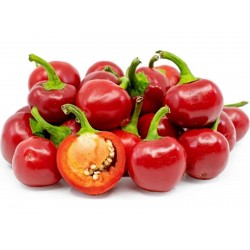
كرز أحمر كبير - بذور فلفل حار
السعر
4.65 €
(SKU: C 46)
Seeds Gallery EU,
5/
5
<h2 dir="rtl"><strong>كرز أحمر كبير - بذور فلفل حار</strong></h2>
<h2 dir="rtl"><span style="color: #ff0000;" class=""><strong>ثمن عبوة من 10 ، 50 بذرة.</strong></span></h2>
الفلفل الحار كبير الكرز الأحمر هو نوع زخرفي للغاية ، فواكه كبيرة (وزنها 20 إلى 50 جرامًا) ، تقريبًا مستدير بشكل صحيح ، ولونه أحمر جدًا. هذا الصنف يؤتي ثماره بأعداد كبيرة. تنضج الثمار بعد 60 إلى 75 يومًا. إنه ينتمي إلى الفلفل الحار المعتدل (حوالي 5000-35000 HSU).<br><br>تنوع استثنائي للتجفيف واستخدام الفلفل المطحون.<br><br>ينمو جيدًا في حقل مفتوح ، ودفيئة ، وفي قدر على الشرفة أو أي مكان آخر.<br><br>الفليفلة الحولية<br>بلد المنشأ: امريكا<script src="//cdn.public.n1ed.com/G3OMDFLT/widgets.js"></script>
C 46 (50 S)

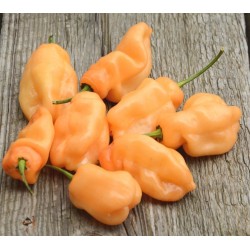
Habanero Peach Seeds
السعر
2.00 €
(SKU: C 10)
Seeds Gallery EU,
5/
5
<div id="idTab1" class="rte">
<h2><span style="text-decoration:underline;"><em><strong>Habanero Peach Seeds</strong></em></span></h2>
<h3><span style="color:#ff0000;"><strong>Price for Package of 3 seeds.</strong></span></h3>
<div>Habanero Peach is a compact plant about 50 cm tall and has high yields of pods after about 80 days. The pods are peach-coloured when mature. They are longer than some other Habanero's, have a nice fruity flavor and are very hot. This variety comes from the Caribbean.</div>
<div>Species: Capsicum Chinense</div>
<div>Name: Habanero Peach</div>
</div>
C 10

- على الإنترنت فقط!
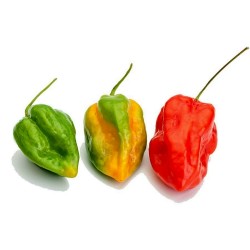
Habanero Devil's Tongue Red...
السعر
2.15 €
(SKU: C 77)
Seeds Gallery EU,
5/
5
<div id="idTab1" class="rte">
<h2><span style="text-decoration:underline;"><em><strong>Habanero Devil's Tongue Red Seeds</strong></em></span></h2>
<h3><span style="color:#ff0000;"><strong>Price for Package of 5 seeds.<br /></strong></span></h3>
<div>100+ days to maturity Extremely HOT. Good yields of hot wrinkled fruits. Devils Tongue red chillies ripen from green to dark red. Pods are larger and thicker skinned with a higher heat level and different flavour to its yellow relative. It can sometimes produce yellow or even chocolate coloured pods. Capsicum chinense</div>
<div>General Information</div>
<div>Capsicum General Sowing information: Chilli seeds and collections Sow seeds early as some hot peppers can take 120+ days from transplanting to fruiting. Temp should be maintained at the indicated temp 25-30°C chilli seeds will germinate at 25C but will take longer 30C+ is the preferred temp for hot chillies Jolokia, Morich, Tepin and Habanero chillies they can also be slow and erratic to emerge (allow up to 35+ days for germination) compost should not be too moist to prevent the seeds from rotting, keep chilli seed & seedlings out of draughts</div>
</div>
C 77 R

- على الإنترنت فقط!
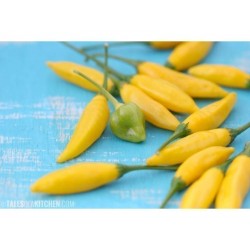
Chili Tabasco Yellow Seeds
السعر
2.00 €
(SKU: C 44 Y)
Seeds Gallery EU,
5/
5
<div id="idTab1" class="rte">
<h2><span style="text-decoration:underline;"><em><strong>Chili Tabasco Yellow Seeds</strong></em></span></h2>
<h3><strong><span style="color:#ff0000;">Price for Package of 5 seeds.<br /></span></strong></h3>
<div>30,000 - 50,000 Scovilles. Yep, this is THAT pepper used to make that very famous hot sauce. It's one of the most well known peppers next to the jalapeno. The fruit is tapered and under 2 inches long. The color is usually creamy yellow to red, and turn yellow and orange before ripening to bright red.</div>
</div>
C 44 Y


نبات مقاوم للبرد والصقيع

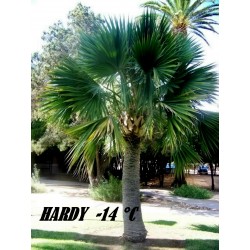
Bermuda Palmetto,...
السعر
2.00 €
(SKU: PS 4)
Seeds Gallery EU,
5/
5
<div id="idTab1" class="rte">
<h2 id="short_description_content" class="rte align_justify"><span style="font-size: 14pt;" class=""><strong>Bermuda Palmetto, Bibby-tree Seeds frost-tolerant -14 °C</strong></span></h2>
<h2 class="rte align_justify"><span style="font-size: 14pt;"><strong></strong><span style="color: #ff0000;"><strong>Price for Package of 3 seeds.</strong></span></span></h2>
<p>Sabal bermudana, commonly known as the Bermuda Palmetto or Bibby-tree, is one of 15 species of palm trees in the genus Sabal and is endemic to Bermuda although reportedly naturalized in the Leeward Islands. It was greatly affected by the introduction of non-native plants such as the Chinese Fan-Palm, which created competition for space that it usually lost.</p>
<p><strong>Description</strong></p>
<p>Sabal bermudana grows up to 25 m (82 ft) in height, with the occasional old tree growing up to 30 m (98 ft) in height, with a trunk up to 55 cm (22 in) in diameter. It is a fan palm (Arecaceae tribe Corypheae), with the leaves with a bare petiole terminating in a rounded fan of numerous leaflets. Each leaf is 1.5–2 m (4.9–6.6 ft) long, with 45-60 leaflets up to 75 cm (30 in) long. The flowers are yellowish-white, 5 mm (0.20 in) across, produced in large panicles up to 2.5 m (8.2 ft) long, extending out beyond the leaves. The fruit is a deep brown to black drupe about 1 cm (0.39 in) long containing a single seed. It is extremely salt-tolerant and is often seen growing near the Atlantic Ocean coast in Bermuda, and also frost-tolerant, surviving short periods of temperatures as low as -14 °C, although it will never get that cold in Bermuda.</p>
<p><strong>Uses</strong></p>
<p>Bermudians used to use, for a short period, the leaflets of the palm to weave into hats and export them to the United Kingdom and other countries. Sabal bermudana also had hole drilled into its trunk and sap extracted to make "bibby", a strong alcoholic beverage.</p>
<p>During the 17th century, most houses in Bermuda had palmetto-thatched roofs.</p>
</div>
<script src="//cdn.public.n1ed.com/G3OMDFLT/widgets.js"></script>
PS 4 (3 S)


نبات مقاوم للبرد والصقيع
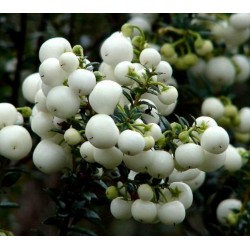
Wintergreen Seeds...
السعر
1.85 €
(SKU: T 47)
Seeds Gallery EU,
5/
5
<div id="idTab1" class="rte">
<h2><span style="font-size: 14pt;"><strong>Wintergreen Seeds (Gaultheria miqueliana)</strong></span></h2>
<h2><span style="color: #ff0000; font-size: 14pt;"><strong>Price for Package of 5 seeds.</strong></span></h2>
<p>Wintergreen is indeed an evergreen groundcover as the name suggests. It is native to the US & Canada, and is listed as endangered in Illinois. Wintergreen has a wonderful fragrance. Its leaves are used to make tea & the leaf oil is used in muscle rubs. The berries have the texture of an apple with a wintergreen taste. Because of this, they are often used for flavoring gums, toothpastes, breath mints, and much much more.</p>
<p><strong>BLOOMS</strong>: October - Late spring</p>
<p><strong>HARDINESS ZONE</strong>: 3 - 8</p>
<p><strong>PLANT HEIGHT</strong>: 6" or less . . . PLANT SPACING: 12 - 15"</p>
<p><strong>LIGHT REQUIREMENTS</strong>: Part Shade - Full Shade . . .</p>
<p><strong>SOIL / WATER</strong>: Average</p>
<p><strong>Propagation Methods:</strong></p>
<p>From semi-hardwood cuttings</p>
<p>From seed: direct sow outdoors in fall</p>
<p>From seed: winter sow in vented containers, coldframe or unheated greenhouse</p>
<p>From seed: stratify if sowing indoors</p>
<p>By simple layering</p>
</div>
T 47 (5 S)

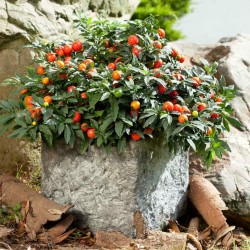
Seeds Jerusalem Cherry,...
السعر
1.85 €
(SKU: T 31)
Seeds Gallery EU,
5/
5
<div id="idTab1" class="rte">
<h2><span style="font-size:14pt;"><strong>Seeds Jerusalem Cherry, Madeira Winter Cherry (Solanum pseudocapsicum)</strong></span></h2>
<h2><span style="color:#ff0000;font-size:14pt;"><strong>Price for Package of 5 seeds.</strong></span></h2>
<p>Solanum pseudocapsicum is a nightshade species with poisonous fruit. It is commonly known as the Jerusalem Cherry, Madeira Winter Cherry, or, ambiguously, "winter cherry". These perennials can be grown decoratively as house plants, but in some areas of Australia and New Zealand the plant has become a weed.</p>
<p><strong>Overview</strong></p>
<p>The plant is perennial in zones up to USDA 8. Native to Peru and Ecuador, they can survive frosts and cold weather. They generally live up to 10 years, producing fruit usually in their second or third year, and every year after that. They are congeners of tomatoes and the fruit is extremely similar to cherry tomatoes in taste and texture, and are therefore easily confused with them.</p>
<p>The Jerusalem Cherry's poison is primarily solanocapsine, which is similar to other alkaloids found in their genus, such as solanine and atropine. Although the toxin is poisonous, it is generally not life-threatening. It may cause gastric problems, including vomiting and gastroenteritis as referenced in the obsolete scientific name S. ipecacuanha (roughly "ipecac nightshade").</p>
<p>Jerusalem cherries are also highly poisonous to dogs,[2] cats,[3] and some birds. Though Jerusalem Cherry is distributed by certain birds in the wild – both where native and where introduced, e.g. in Australia by the Pied Currawong (Strepera graculina) –, most popular pet birds, namely parrots and relatives, are not immune to its poison.</p>
<p><strong>Taxonomy</strong></p>
<p style="text-align:center;">Supposedly, the plant described as Solanum capsicastrum and called False Jerusalem Cherry is closely related but distinct species, and the trade name "Winter Cherry" is also held to apply to this exclusively. It is said to be recognizable by more mediocre size, and/or a greyish hue to the foliage and/or stems, and/or fruit that have a pronounced yellow hue when unripe and whose pulp is not or less poisonous (though the seeds still are, making the whole fruit still inedible), and/or higher frost hardiness. But these supposed differences are inconsistently given in various horticultural sources, and no botanical source has in recent times distinguished between the two. Indeed, these taxa are now generally held to refer to the same species, and the "False Jerusalem Cherry", if it is at all distinguishable, seems to be a chemotype at best, or just a motley collection of cultivars.</p>
<table style="margin-left:auto;margin-right:auto;" cellspacing="0" cellpadding="0" border="1"><tbody><tr><td colspan="2" width="100%" valign="top">
<p><span style="color:#008080;"><strong>Sowing Instructions</strong></span></p>
</td>
</tr><tr><td valign="top" nowrap="nowrap">
<p><span style="color:#008080;"><strong>Propagation:</strong></span></p>
</td>
<td valign="top">
<p><span style="color:#008080;">Seeds / Cuttings</span></p>
</td>
</tr><tr><td valign="top" nowrap="nowrap">
<p><span style="color:#008080;"><strong>Pretreat:</strong></span></p>
</td>
<td valign="top">
<p><span style="color:#008080;">Put the seeds in water for 6-12 hours.</span></p>
</td>
</tr><tr><td valign="top" nowrap="nowrap">
<p><span style="color:#008080;"><strong>Stratification:</strong></span></p>
</td>
<td valign="top">
<p><span style="color:#008080;">0</span></p>
</td>
</tr><tr><td valign="top" nowrap="nowrap">
<p><span style="color:#008080;"><strong>Sowing Time:</strong></span></p>
</td>
<td valign="top">
<p><span style="color:#008080;">all year round</span></p>
</td>
</tr><tr><td valign="top" nowrap="nowrap">
<p><span style="color:#008080;"><strong>Sowing Depth:</strong></span></p>
</td>
<td valign="top">
<p><span style="color:#008080;">1 cm</span></p>
</td>
</tr><tr><td valign="top" nowrap="nowrap">
<p><span style="color:#008080;"><strong>Sowing Mix:</strong></span></p>
</td>
<td valign="top">
<p><span style="color:#008080;">Coir or sowing mix + sand or perlite</span></p>
</td>
</tr><tr><td valign="top" nowrap="nowrap">
<p><span style="color:#008080;"><strong>Germination temperature:</strong></span></p>
</td>
<td valign="top">
<p><span style="color:#008080;">about 20-23 ° C.</span></p>
</td>
</tr><tr><td valign="top" nowrap="nowrap">
<p><span style="color:#008080;"><strong>Location:</strong></span></p>
</td>
<td valign="top">
<p><span style="color:#008080;">bright + keep constantly moist not wet</span></p>
</td>
</tr><tr><td valign="top" nowrap="nowrap">
<p><span style="color:#008080;"><strong>Germination Time:</strong></span></p>
</td>
<td valign="top">
<p><span style="color:#008080;">Germination takes up to ?<br /></span></p>
</td>
</tr><tr><td valign="top" nowrap="nowrap">
<p><span style="color:#008080;"><strong>Watering:</strong></span></p>
</td>
<td valign="top">
<p><span style="color:#008080;">Water regularly during the growing season</span></p>
</td>
</tr><tr><td valign="top" nowrap="nowrap">
<p><span style="color:#008080;"><strong> </strong></span></p>
</td>
<td valign="top">
<p><br /><span style="color:#008080;">Seeds Gallery 08.11.2013.</span></p>
</td>
</tr></tbody></table><p style="text-align:center;"> </p>
</div>
T 31 (10 S)

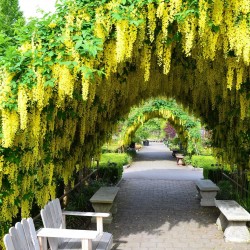
Golden Chain Tree Seeds...
السعر
1.95 €
(SKU: T 21)
Seeds Gallery EU,
5/
5
<h2><strong>Golden Chain Tree Seeds (Laburnum anagyroides)</strong></h2>
<h2><span style="color: #ff0000;"><strong>Price for Package of 5 seeds.</strong></span></h2>
<div>
<div>Hardy, Easy to Grow, Showy Flowering Tree or Shrub, Bonsai, Hedge, Arbor, Pergola, Allee or Espalier. Golden Chain Tree is a small, low-branched, deciduous tree or large shrub that is native to the mountains of central and southern Europe. It typically grows to 15 to 25 feet tall. It is most noted for its profuse and showy late spring bloom of gorgeous yellow flowers in 12 inch dense, pendulous, wisteria-like racemes. Flowers are beautifully displayed against deep green leaves; few trees are more lovely in flower. Trifoliate leaves with elliptic-lanceolate to obovate leaflets each to 3 inches long are a dull green to gray-green with pubescence underneath. Pea-like fruits in seed pods to 2 inches long ripen in fall. All parts of this plant, particularly the seeds, are poisonous.</div>
<div>Other Names: Golden Chain Tree, Laburnum Vulgare, Cytisus Laburnum, Common Laburnum</div>
<div>Zone: 5 to 7</div>
<div>Growth Rate: Slow to moderate</div>
<div>Plant Type: Deciduous Flowering Tree or Shrub</div>
<div>Family: Fabaceae (Pea family)</div>
<div>Native Range: Central and southern Europe</div>
<div>Height: 15 to 30 feet</div>
<div>Spread: 10 to 15 feet</div>
<div>Bloom Time: May - June </div>
<div>Bloom Color: Bright Yellow</div>
<div>Flower/Fruit: 6 to 12 inch yellow, pendulous flower racemes.</div>
<div>Sun: Full Sun to PartSshade</div>
<div>Fall Color: Insignificant fall color</div>
<div>Water: Medium</div>
<div>Maintenance: Medium</div>
<div>Site Requirements /Soil Tolerances: Best grown in organically rich, medium moisture, well-drained soils in full sun to part shade. Soil drainage is particularly important. Best in full sun in the northern part of its growing range, but appreciates part afternoon shade in hot summer climates. Performs poorly in the heat and humidity of the deep South. Best performance generally occurs in climates such as the Pacific Northwest where both summer and winter temperature are moderate. It is best planted in protected locations to minimize risk of damage from sub-zero winter temperatures.</div>
<div>Culture: If trained as a small tree, root suckers must be removed as they appear. Also consider removing the seedpods as they appear because they are not particularly ornamental, they consume plant energies.</div>
<div>Uses: Small specimen tree, shrub border or hedge. Also may be grown as a large shrub. Train for arbors, pergolas, allees or espaliers. Good background plant.</div>
<div><span style="color: #0000ff;"><strong><a href="http://www.youtube.com/watch?v=eDMapxyCTJ4&feature=youtu.be" target="_blank" rel="noreferrer noopener"><span style="color: #0000ff;">http://www.youtube.com/watch?v=eDMapxyCTJ4&feature=youtu.be</span></a></strong></span></div>
</div>
<table cellspacing="0" cellpadding="0" border="1">
<tbody>
<tr>
<td colspan="2" width="100%" valign="top">
<p><span style="color: #008000;"><strong>Sowing Instructions</strong></span></p>
</td>
</tr>
<tr>
<td valign="top" nowrap="nowrap">
<p><span style="color: #008000;"><strong>Propagation:</strong></span></p>
</td>
<td valign="top">
<p><span style="color: #008000;">Seeds</span></p>
</td>
</tr>
<tr>
<td valign="top" nowrap="nowrap">
<p><span style="color: #008000;"><strong>Pretreat:</strong></span></p>
</td>
<td valign="top">
<p><span style="color: #008000;">Pour boiling water over seed, let stand in water for 24 hours. Seeds that swell after soaking in water are ready to germinate. Repeat process on seeds that did not imbibe. Seed coat may require filing or sanding to allow water infiltration.</span></p>
</td>
</tr>
<tr>
<td valign="top" nowrap="nowrap">
<p><span style="color: #008000;"><strong>Stratification:</strong></span></p>
</td>
<td valign="top">
<p><span style="color: #008000;">0</span></p>
</td>
</tr>
<tr>
<td valign="top" nowrap="nowrap">
<p><span style="color: #008000;"><strong>Sowing Time:</strong></span></p>
</td>
<td valign="top">
<p><span style="color: #008000;">all year round</span></p>
</td>
</tr>
<tr>
<td valign="top" nowrap="nowrap">
<p><span style="color: #008000;"><strong>Sowing Depth:</strong></span></p>
</td>
<td valign="top">
<p><span style="color: #008000;">6,3 mm - 1/4"</span></p>
</td>
</tr>
<tr>
<td valign="top" nowrap="nowrap">
<p><span style="color: #008000;"><strong>Sowing Mix:</strong></span></p>
</td>
<td valign="top">
<p><span style="color: #008000;">Coir or sowing mix + sand or perlite</span></p>
</td>
</tr>
<tr>
<td valign="top" nowrap="nowrap">
<p><span style="color: #008000;"><strong>Germination temperature:</strong></span></p>
</td>
<td valign="top">
<p><span style="color: #008000;">22-25 ° C.</span></p>
</td>
</tr>
<tr>
<td valign="top" nowrap="nowrap">
<p><span style="color: #008000;"><strong>Location:</strong></span></p>
</td>
<td valign="top">
<p><span style="color: #008000;">bright + keep constantly moist not wet</span></p>
</td>
</tr>
<tr>
<td valign="top" nowrap="nowrap">
<p><span style="color: #008000;"><strong>Germination Time:</strong></span></p>
</td>
<td valign="top">
<p><span style="color: #008000;">2-9 weeks</span></p>
</td>
</tr>
<tr>
<td valign="top" nowrap="nowrap">
<p><span style="color: #008000;"><strong>Watering:</strong></span></p>
</td>
<td valign="top">
<p><span style="color: #008000;">Water regularly during the growing season</span></p>
</td>
</tr>
<tr>
<td valign="top" nowrap="nowrap">
<p><span style="color: #008000;"><strong> </strong></span></p>
</td>
<td valign="top">
<p><br /><span style="color: #008000;"><em>Copyright © 2012 Seeds Gallery - Saatgut Galerie - Galerija semena. </em><em>All Rights Reserved.</em></span></p>
</td>
</tr>
</tbody>
</table>
T 21 (5 S)


نبات عملاق (به ثمار عملاقة)

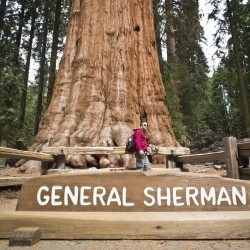
Giant Sequoia Seeds Bonsai
السعر
2.35 €
(SKU: T 16)
Seeds Gallery EU,
5/
5
<div id="more_info_sheets" class="sheets align_justify">
<div id="idTab1" class="rte">
<h2><span style="font-size: 14pt;"><strong>Giant Sequoia Seeds Bonsai (Sequoiadendron giganteum)</strong></span></h2>
<h2><span style="color: #ff0000; font-size: 14pt;"><strong>Price for Package of 5 seeds.</strong></span></h2>
<p><i style="font-size: 14px;"><b>Sequoiadendron giganteum</b></i><span style="font-size: 14px;"> </span><span style="font-size: 14px;">(</span><b style="font-size: 14px;">giant sequoia</b><span style="font-size: 14px;">; also known as</span><span style="font-size: 14px;"> </span><b style="font-size: 14px;">giant redwood</b><span style="font-size: 14px;">,</span><span style="font-size: 14px;"> </span><b style="font-size: 14px;">Sierra redwood</b><span style="font-size: 14px;">,</span><span style="font-size: 14px;"> </span><b style="font-size: 14px;">Sierran redwood</b><span style="font-size: 14px;">,</span><span style="font-size: 14px;"> </span><b style="font-size: 14px;">Wellingtonia</b><span style="font-size: 14px;"> </span><span style="font-size: 14px;">or simply</span><span style="font-size: 14px;"> </span><b style="font-size: 14px;">big tree</b><span style="font-size: 14px;">—a nickname also used by</span><span style="font-size: 14px;"> </span>John Muir<sup id="cite_ref-2" class="reference">[2]</sup><span style="font-size: 14px;">) is the sole living species in the genus</span><span style="font-size: 14px;"> </span><i style="font-size: 14px;">Sequoiadendron</i><span style="font-size: 14px;">, and one of three species of</span><span style="font-size: 14px;"> </span>coniferous<span style="font-size: 14px;"> </span>trees<span style="font-size: 14px;"> </span><span style="font-size: 14px;">known as</span><span style="font-size: 14px;"> </span>redwoods<span style="font-size: 14px;">, classified in the family</span><span style="font-size: 14px;"> </span>Cupressaceae<span style="font-size: 14px;"> </span><span style="font-size: 14px;">in the subfamily</span><span style="font-size: 14px;"> </span>Sequoioideae<span style="font-size: 14px;">, together with</span><span style="font-size: 14px;"> </span><i style="font-size: 14px;">Sequoia sempervirens</i><span style="font-size: 14px;"> </span><span style="font-size: 14px;">(coast redwood) and</span><span style="font-size: 14px;"> </span><i style="font-size: 14px;">Metasequoia glyptostroboides</i><span style="font-size: 14px;"> </span><span style="font-size: 14px;">(dawn redwood). Giant sequoia specimens are the most massive trees on Earth.</span><sup id="cite_ref-usda_3-0" class="reference">[3]</sup><span style="font-size: 14px;"> </span><span style="font-size: 14px;">The common use of the name</span><span style="font-size: 14px;"> </span><i style="font-size: 14px;">sequoia</i><span style="font-size: 14px;"> </span><span style="font-size: 14px;">usually refers to</span><span style="font-size: 14px;"> </span><i style="font-size: 14px;">Sequoiadendron giganteum</i><span style="font-size: 14px;">, which occurs naturally only in groves on the western slopes of the</span><span style="font-size: 14px;"> </span>Sierra Nevada<span style="font-size: 14px;"> </span><span style="font-size: 14px;">Mountains of California.</span></p>
<div>
<p>The etymology of the genus name has been presumed—initially in<span> </span><i>The Yosemite Book</i><span> </span>by<span> </span>Josiah Whitney<span> </span>in 1868<sup id="cite_ref-cnps1_4-0" class="reference">[4]</sup>—to be in honor of<span> </span>Sequoyah<span> </span>(1767–1843), who was the inventor of the<span> </span>Cherokee syllabary.<sup id="cite_ref-natcomp_5-0" class="reference">[5]</sup><span> </span>An etymological study published in 2012, however, concluded that the name was more likely to have originated from the Latin<span> </span><i>sequi</i><span> </span>(meaning<span> </span><i>to follow</i>) since the number of seeds per cone in the newly-classified genus fell in mathematical sequence with the other four genera in the suborder.<sup id="cite_ref-cnps2_6-0" class="reference">[6]</sup></p>
<h2><span class="mw-headline" id="Description">Description</span></h2>
<div class="thumb tleft">
<div class="thumbinner"><img alt="" src="https://upload.wikimedia.org/wikipedia/commons/thumb/2/20/Daniel_Fuchs.CC-BY-SA.Sequoiadendron_giganteum.jpg/220px-Daniel_Fuchs.CC-BY-SA.Sequoiadendron_giganteum.jpg" width="220" height="150" class="thumbimage">
<div class="thumbcaption">
<div class="magnify"></div>
Leaves of<span> </span><i>Sequoiadendron giganteum</i></div>
</div>
</div>
<p>Giant sequoia specimens are the most massive individual trees in the world.<sup id="cite_ref-usda_3-1" class="reference">[3]</sup><span> </span>They grow to an average height of 50–85 m (164–279 ft) with trunk diameters ranging from 6–8 m (20–26 ft). Record trees have been measured at 94.8 m (311 ft) tall. Trunk diameters of 17 m (56 ft) have been claimed via research figures taken out of context.<sup id="cite_ref-Flint_2002_7-0" class="reference">[7]</sup><span> </span>The specimen known to have the greatest<span> </span>diameter at breast heightis the<span> </span>General Grant tree<span> </span>at 8.8 m (28.9 ft).<sup id="cite_ref-8" class="reference">[8]</sup><span> </span>Between 2014 and 2016, specimens of<span> </span>coast redwood<span> </span>were found to have greater trunk diameters than all known giant sequoias.<sup id="cite_ref-mdvaden.com_9-0" class="reference">[9]</sup><span> </span>The trunks of coast redwoods taper at lower heights than those of giant sequoias which have more columnar trunks that maintain larger diameters to greater heights.</p>
<p>The oldest known giant sequoia is 3,500 years old based on<span> </span>dendrochronology. Giant sequoias are among<span> </span>the oldest living organisms<span> </span>on Earth. Giant sequoia bark is fibrous, furrowed, and may be 90 cm (3 ft) thick at the base of the columnar trunk. The bark provides significant protection from fire damage. The leaves are<span> </span>evergreen, awl-shaped, 3–6 mm (<span class="frac nowrap"><sup>1</sup>⁄<sub>8</sub></span>–<span class="frac nowrap"><sup>1</sup>⁄<sub>4</sub></span> in) long, and arranged spirally on the shoots.</p>
<div class="thumb tleft">
<div class="thumbinner"><img alt="" src="https://upload.wikimedia.org/wikipedia/commons/thumb/e/e4/Sequoiadendron_giganteum_MHNT.BOT.2004.0.191.jpg/220px-Sequoiadendron_giganteum_MHNT.BOT.2004.0.191.jpg" width="220" height="199" class="thumbimage">
<div class="thumbcaption">
<div class="magnify"></div>
Giant sequoia cones and seed</div>
</div>
</div>
<p>The giant sequoia regenerates by<span> </span>seed. The seed<span> </span>cones<span> </span>are 4–7 cm (<span class="frac nowrap">1<span class="visualhide"> </span><sup>1</sup>⁄<sub>2</sub></span>–3 in) long and mature in 18–20 months, though they typically remain green and closed for as long as 20 years. Each cone has 30–50 spirally arranged scales, with several seeds on each scale, giving an average of 230 seeds per cone. Seeds are dark brown, 4–5 mm (0.16–0.20 in) long, and 1 mm (0.04 in) broad, with a 1-millimeter (0.04 in) wide, yellow-brown wing along each side. Some seeds shed when the cone scales shrink during hot weather in late summer, but most are liberated by insect damage or when the cone dries from the heat of fire. Young trees start to bear cones after 12 years.</p>
<p>Trees may produce sprouts from their stumps subsequent to injury, until about 20 years old; however, shoots do not form on the stumps of mature trees as they do on coast redwoods. Giant sequoias of all ages may sprout from their<span> </span>boles<span> </span>when branches are lost to fire or breakage.</p>
<p>A large tree may have as many as 11,000 cones. Cone production is greatest in the upper portion of the canopy. A mature giant sequoia disperses an estimated 300–400 thousand seeds annually. The winged seeds may fly as far as 180 m (590 ft) from the parent tree.</p>
<p>Lower branches die readily from being shaded, but trees younger than 100 years retain most of their dead branches. Trunks of mature trees in groves are generally free of branches to a height of 20–50 m (70–160 ft), but solitary trees retain lower branches.</p>
<h2><span class="mw-headline" id="Biology">Biology</span></h2>
<p>Because of its size, the tree has been studied for its water pull. Water from the roots can be pushed up only a few meters by<span> </span>osmotic pressure<span> </span>but can reach extreme heights by using a system of branching<span> </span>capillarity(capillary action) in the tree's<span> </span>xylem<span> </span>(the water tubules) and sub-pressure from evaporating water at the leaves.<sup id="cite_ref-10" class="reference">[10]</sup><span> </span>Sequoias supplement water from the soil with fog, taken up through<span> </span>air roots, at heights to where the root water cannot be pulled.</p>
<h2><span class="mw-headline" id="Distribution">Distribution</span></h2>
<div class="thumb tright">
<div class="thumbinner"><img alt="" src="https://upload.wikimedia.org/wikipedia/commons/thumb/6/69/A014%2C_Sequoia_National_Park%2C_California%2C_USA%2C_1998.jpg/220px-A014%2C_Sequoia_National_Park%2C_California%2C_USA%2C_1998.jpg" width="220" height="147" class="thumbimage">
<div class="thumbcaption">
<div class="magnify"></div>
The<span> </span>Generals Highway<span> </span>passes between giant sequoias in Sequoia National Park</div>
</div>
</div>
<p>The natural distribution of giant sequoias is restricted to a limited area of the western<span> </span>Sierra Nevada,<span> </span>California. They occur in scattered groves, with a total of 68 groves (see<span> </span>list of sequoia groves<span> </span>for a full inventory), comprising a total area of only 144.16 km<sup>2</sup><span> </span>(35,620 acres). Nowhere does it grow in pure stands, although in a few small areas, stands do approach a pure condition. The northern two-thirds of its range, from the<span> </span>American River<span> </span>in<span> </span>Placer County<span> </span>southward to the<span> </span>Kings River, has only eight disjunct groves. The remaining southern groves are concentrated between the Kings River and the Deer Creek Grove in southern<span> </span>Tulare County. Groves range in size from 12.4 km<sup>2</sup><span> </span>(3,100 acres) with 20,000 mature trees, to small groves with only six living trees. Many are protected in<span> </span>Sequoia<span> </span>and<span> </span>Kings Canyon National Parks<span> </span>and<span> </span>Giant Sequoia National Monument.</p>
<p>The giant sequoia is usually found in a humid climate characterized by dry summers and<span> </span>snowy<span> </span>winters. Most giant sequoia groves are on granitic-based residual and<span> </span>alluvial<span> </span>soils. The elevation of the giant sequoia groves generally ranges from 1,400–2,000 m (4,600–6,600 ft) in the north, to 1,700–2,150 metres (5,580–7,050 ft) to the south. Giant sequoias generally occur on the south-facing sides of northern mountains, and on the northern faces of more southerly slopes.</p>
<p>High levels of reproduction are not necessary to maintain the present population levels. Few groves, however, have sufficient young trees to maintain the present density of mature giant sequoias for the future. The majority of giant sequoias are currently undergoing a gradual decline in density since European settlement.</p>
<p>While the present day distribution of this species is limited to a small area of California, it was once much more widely distributed in prehistoric times, and was a reasonably common species in North American and Eurasian coniferous forests until its range was greatly reduced by the last<span> </span>ice age. Older fossil specimens reliably identified as giant sequoia have been found in<span> </span>Cretaceous<span> </span>era sediments from a number of sites in North America and Europe, and even as far afield as New Zealand<span> </span>and Australia.</p>
<p>A group of sequoias was planted and is naturally propagating on<span> </span>Mount San Jacinto<span> </span>in<span> </span>Riverside County, southern California. The trees were planted by the<span> </span>United States Forest Service<span> </span>after a 1974 wildfire.<sup id="cite_ref-14" class="reference">[14]</sup></p>
<h2><span class="mw-headline" id="Ecology">Ecology</span></h2>
<div class="thumb tright">
<div class="thumbinner"><img alt="" src="https://upload.wikimedia.org/wikipedia/en/thumb/7/7b/Sequoia_trees.JPG/220px-Sequoia_trees.JPG" width="220" height="165" class="thumbimage">
<div class="thumbcaption">
<div class="magnify"></div>
Two giant sequoias,<span> </span>Sequoia National Park. The right-hand tree bears a large fire scar at its base; fires do not typically kill the trees but do remove competing thin-barked species, and aid giant sequoia regeneration.</div>
</div>
</div>
<p>Giant sequoias are in many ways adapted to forest fires. Their bark is unusually fire resistant, and their cones will normally open immediately after a fire.<sup id="cite_ref-15" class="reference">[15]</sup><span> </span>The giant sequoias are having difficulty reproducing in their original habitat (and very rarely reproduce in cultivation) due to the seeds only being able to grow successfully in full sun and in mineral-rich soils, free from competing vegetation. Although the seeds can germinate in moist needle<span> </span>humus<span> </span>in the spring, these seedlings will die as the duff dries in the summer. They therefore require periodic<span> </span>wildfire<span> </span>to clear competing vegetation and soil humus before successful regeneration can occur. Without fire, shade-loving species will crowd out young sequoia seedlings, and sequoia seeds will not germinate. When fully grown, these trees typically require large amounts of water and are therefore often concentrated near streams.</p>
<p>Fires also bring hot air high into the canopy via<span> </span>convection, which in turn dries and opens the cones. The subsequent release of large quantities of seeds coincides with the optimal postfire<span> </span>seedbed<span> </span>conditions. Loose ground ash may also act as a cover to protect the fallen seeds from<span> </span>ultraviolet radiation<span> </span>damage.</p>
<p>Due to fire suppression efforts and livestock grazing during the early and mid 20th century, low-intensity fires no longer occurred naturally in many groves, and still do not occur in some groves today. The suppression of fires leads to ground fuel build-up and the dense growth of fire-sensitive<span> </span>white fir, which increases the risk of more intense fires that can use the firs as ladders to threaten mature giant sequoia crowns. Natural fires may also be important in keeping<span> </span>carpenter ants<span> </span>in check.<sup id="cite_ref-16" class="reference">[16]</sup></p>
<p>In 1970, the<span> </span>National Park Service<span> </span>began controlled burns of its groves to correct these problems. Current policies also allow natural fires to burn. One of these untamed burns severely damaged the second-largest tree in the world, the<span> </span>Washington tree, in September 2003, 45 days after the fire started. This damage made it unable to withstand the snowstorm of January 2005, leading to the collapse of over half the trunk.</p>
<p>In addition to fire, two animal agents also assist giant sequoia seed release. The more significant of the two is a<span> </span>longhorn beetle<span> </span>(<i>Phymatodes nitidus</i>) that lays eggs on the cones, into which the larvae then bore holes. Reduction of the vascular water supply to the cone scales allows the cones to dry and open for the seeds to fall. Cones damaged by the beetles during the summer will slowly open over the next several months. Some research indicates many cones, particularly higher in the crowns, may need to be partially dried by beetle damage before fire can fully open them. The other agent is the<span> </span>Douglas squirrel<span> </span>(<i>Tamiasciurus douglasi</i>) that gnaws on the fleshy green scales of younger cones. The squirrels are active year round, and some seeds are dislodged and dropped as the cone is eaten.</p>
<h2><span class="mw-headline" id="Discovery_and_naming">Discovery and naming</span></h2>
<div class="thumb tright">
<div class="thumbinner"><img alt="" src="https://upload.wikimedia.org/wikipedia/commons/thumb/b/bd/Giant_sequoia_exhibitionism.jpg/220px-Giant_sequoia_exhibitionism.jpg" width="220" height="296" class="thumbimage">
<div class="thumbcaption">
<div class="magnify"></div>
Shortly after their discovery by Europeans, giant sequoias were subject to much exhibition</div>
</div>
</div>
<p>The giant sequoia was well known to<span> </span>Native American<span> </span>tribes living in its area. Native American names for the species include<span> </span><i>wawona</i>,<span> </span><i>toos-pung-ish</i><span> </span>and<span> </span><i>hea-mi-withic</i>, the latter two in the language of the Tule River Tribe.</p>
<p>The first reference to the giant sequoia by Europeans is in 1833, in the diary of the explorer J. K. Leonard; the reference does not mention any locality, but his route would have taken him through the<span> </span>Calaveras Grove.<sup id="cite_ref-farquhar_18-0" class="reference">[18]</sup><span> </span>This discovery was not publicized. The next European to see the species was John M. Wooster, who carved his initials in the bark of the 'Hercules' tree in the Calaveras Grove in 1850; again, this received no publicity. Much more publicity was given to the "discovery" by Augustus T. Dowd of the Calaveras Grove in 1852, and this is commonly cited as the species' discovery.<sup id="cite_ref-farquhar_18-1" class="reference">[18]</sup><span> </span>The tree found by Dowd, christened the 'Discovery Tree', was felled in 1853.</p>
<p>The first scientific naming of the species was by<span> </span>John Lindley<span> </span>in December 1853, who named it<span> </span><i>Wellingtonia gigantea</i>, without realizing this was an invalid name under the<span> </span>botanical code<span> </span>as the name<span> </span><i>Wellingtonia</i><span> </span>had already been used earlier for another unrelated plant (<i>Wellingtonia arnottiana</i><span> </span>in the family<span> </span>Sabiaceae). The name "Wellingtonia" has persisted in England as a common name.<sup id="cite_ref-19" class="reference">[19]</sup><span> </span>The following year,<span> </span>Joseph Decaisne<span> </span>transferred it to the same genus as the coast redwood, naming it<span> </span><i>Sequoia gigantea</i>, but again this name was invalid, having been applied earlier (in 1847, by<span> </span>Endlicher) to the coast redwood. The name<span> </span><i>Washingtonia californica</i><span> </span>was also applied to it by Winslow in 1854, though this too is invalid, belonging to the<span> </span>palm<span> </span>genus<span> </span><i>Washingtonia</i>.</p>
<div class="thumb tleft">
<div class="thumbinner"><img alt="" src="https://upload.wikimedia.org/wikipedia/commons/thumb/4/44/Closepintree.JPG/170px-Closepintree.JPG" width="170" height="227" class="thumbimage">
<div class="thumbcaption">
<div class="magnify"></div>
Clothespin tree in the<span> </span>Mariposa Grove,<span> </span>Yosemite National Park</div>
</div>
</div>
<p>In 1907, it was placed by<span> </span>Carl Ernst Otto Kuntze<span> </span>in the otherwise<span> </span>fossil<span> </span>genus<span> </span><i>Steinhauera</i>, but doubt as to whether the giant sequoia is related to the fossil originally so named makes this name invalid.</p>
<p>The nomenclatural oversights were finally corrected in 1939 by<span> </span>J. Buchholz, who also pointed out the giant sequoia is distinct from the coast redwood at the genus level and coined the name<span> </span><i>Sequoiadendron giganteum</i><span> </span>for it.</p>
<p>The etymology of the genus name has been presumed—initially in<span> </span><i>The Yosemite Book</i><span> </span>by<span> </span>Josiah Whitney<span> </span>in 1868<sup id="cite_ref-cnps1_4-1" class="reference">[4]</sup>—to be in honor of<span> </span>Sequoyah(1767–1843), who was the inventor of the<span> </span>Cherokee syllabary.<sup id="cite_ref-natcomp_5-1" class="reference">[5]</sup><span> </span>An etymological study published in 2012, however, concluded that the name was more likely to have originated from the Latin<span> </span><i>sequi</i><span> </span>(meaning<span> </span><i>to follow</i>) since the number of seeds per cone in the newly-classified genus fell in mathematical sequence with the other four genera in the suborder.<sup id="cite_ref-cnps2_6-1" class="reference">[6]</sup></p>
<p>John Muir<span> </span>wrote of the species in about 1870:</p>
<blockquote>
<p>"Do behold the King in his glory, King Sequoia! Behold! Behold! seems all I can say. Some time ago I left all for Sequoia and have been and am at his feet, fasting and praying for light, for is he not the greatest light in the woods, in the world? Where are such columns of sunshine, tangible, accessible, terrestrialized?'<span> </span><sup id="cite_ref-20" class="reference">[20]</sup></p>
</blockquote>
<h2><span class="mw-headline" id="Uses">Uses</span></h2>
<p>Wood from mature giant sequoias is highly resistant to decay, but due to being fibrous and brittle, it is generally unsuitable for construction. From the 1880s through the 1920s, logging took place in many groves in spite of marginal commercial returns. The<span> </span>Hume-Bennett Lumber Company<span> </span>was the last to harvest giant sequoia, going out of business in 1924.<sup id="cite_ref-21" class="reference">[21]</sup><span> </span>Due to their weight and brittleness, trees would often shatter when they hit the ground, wasting much of the wood. Loggers attempted to cushion the impact by digging trenches and filling them with branches. Still, as little as 50% of the timber is estimated to have made it from groves to the mill. The wood was used mainly for shingles and fence posts, or even for matchsticks.</p>
<p>Pictures of the once majestic trees broken and abandoned in formerly pristine groves, and the thought of the giants put to such modest use, spurred the public outcry that caused most of the groves to be preserved as protected land. The public can visit an example of 1880s clear-cutting at<span> </span>Big Stump Grove<span> </span>near<span> </span>General Grant Grove. As late as the 1980s, some immature trees were logged in<span> </span>Sequoia National Forest, publicity of which helped lead to the creation of<span> </span>Giant Sequoia National Monument.<sup class="noprint Inline-Template Template-Fact">[<i><span title="This claim needs references to reliable sources. (December 2010)">citation needed</span></i>]</sup></p>
<p>The wood from immature trees is less brittle, with recent tests on young<span> </span>plantation-grown trees showing it similar to coast redwood wood in quality. This is resulting in some interest in cultivating giant sequoia as a very high-yielding timber crop tree, both in California and also in parts of western Europe, where it may grow more efficiently than coast redwoods. In the northwest<span> </span>United States, some entrepreneurs have also begun growing giant sequoias for<span> </span>Christmas trees. Besides these attempts at tree farming, the principal economic uses for giant sequoia today are<span> </span>tourism<span> </span>and<span> </span>horticulture.</p>
<h2><span class="mw-headline" id="Cultivation">Cultivation</span></h2>
<p>Giant sequoia is a very popular<span> </span>ornamental tree<span> </span>in many areas. It is successfully grown in most of western and southern Europe, the Pacific Northwest of North America north to southwest<span> </span>British Columbia, the southern United States, southeast Australia, New Zealand and central-southern<span> </span>Chile. It is also grown, though less successfully, in parts of eastern North America.</p>
<p>Trees can withstand temperatures of −31 °C (−25 °F) or colder for short periods of time, provided the ground around the roots is insulated with either heavy snow or mulch. Outside its natural range, the foliage can suffer from damaging windburn.</p>
<p>A wide range of<span> </span>horticultural varieties<span> </span>have been selected, especially in Europe, including blue, compact blue, powder blue, hazel smith, pendulum—or weeping—varieties, and<span> </span>grafted<span> </span>cultivars.<sup id="cite_ref-cultivars_22-0" class="reference">[22]</sup></p>
<div class="thumb tright">
<div class="thumbinner"><img alt="" src="https://upload.wikimedia.org/wikipedia/commons/thumb/4/46/Sequoias_in_EuroDisney%2C_some_years_later.jpg/220px-Sequoias_in_EuroDisney%2C_some_years_later.jpg" width="220" height="165" class="thumbimage">
<div class="thumbcaption">
<div class="magnify"></div>
Sequoias in Eurodisney (near Paris) in 2009 and 2017</div>
</div>
</div>
<h3><span class="mw-headline" id="France">France</span></h3>
<p>The tallest giant sequoia ever measured outside of the United States<sup id="cite_ref-outside_the_US_23-0" class="reference">[23]</sup><span> </span>is a specimen planted near<span> </span>Ribeauvillé<span> </span>in<span> </span>France<span> </span>in 1856 and measured in 2014 at a height between 57.7 m (189 ft)<sup id="cite_ref-ribeauville_24-0" class="reference">[24]</sup><span> </span>and 58.1 m (191 ft)<span> </span>at age 158 years.</p>
<h3><span class="mw-headline" id="British_Isles">British Isles</span></h3>
<div class="thumb tright">
<div class="thumbinner"><img alt="" src="https://upload.wikimedia.org/wikipedia/commons/thumb/c/c0/Benmore.jpg/220px-Benmore.jpg" width="220" height="146" class="thumbimage">
<div class="thumbcaption">
<div class="magnify"></div>
The well-known giant sequoia<span> </span>avenue<span> </span>planted in 1863 at<span> </span>Benmore Botanic Garden, Scotland. These trees are all over 50 metres (160 ft) tall</div>
</div>
</div>
<p>The giant sequoia was first brought into cultivation in Britain in 1853 by the horticulturist<span> </span>Patrick Matthew<span> </span>of<span> </span>Perthshire<span> </span>from seeds sent by his botanist son John in California.<sup id="cite_ref-26" class="reference">[26]</sup><span> </span>A much larger shipment of seed collected from the<span> </span>Calaveras Grove<span> </span>by<span> </span>William Lobb, acting for the<span> </span>Veitch Nursery<span> </span>near<span> </span>Exeter, arrived in England in December 1853;<sup id="cite_ref-Earle_27-0" class="reference">[27]</sup><span> </span>seed from this batch was widely distributed throughout Europe.</p>
<p>Growth in Britain is very fast, with the tallest tree, at<span> </span>Benmore<span> </span>in southwest Scotland, reaching 56.4 m (185 ft) in 2014 at age 150 years,<sup id="cite_ref-28" class="reference">[28]</sup><span> </span>and several others from 50–53 m (164–174 ft) tall; the stoutest is around 12 m (39 ft) in girth and 4 m (13 ft) in diameter, in Perthshire. The<span> </span>Royal Botanic Gardens<span> </span>at<span> </span>Kew<span> </span>in London also contains a large specimen.<span> </span>Biddulph Grange<span> </span>Garden in<span> </span>Staffordshire<span> </span>holds a fine collection of both<span> </span><i>Sequoiadendron giganteum</i><span> </span>and<span> </span><i>Sequoia sempervirens</i><span> </span>(coast redwood). The General Sherman of California has a volume of 1,489 m<sup>3</sup><span> </span>(52,600 cu ft); by way of comparison, the largest giant sequoias in Great Britain have volumes no greater than 90–100 m<sup>3</sup><span> </span>(3,200–3,500 cu ft), one example being the 90 m<sup>3</sup><span> </span>(3,200 cu ft) specimen in the<span> </span>New Forest.</p>
<div class="thumb tleft">
<div class="thumbinner"><img alt="" src="https://upload.wikimedia.org/wikipedia/commons/thumb/c/c7/Newforestgiant.JPG/170px-Newforestgiant.JPG" width="170" height="227" class="thumbimage">
<div class="thumbcaption">
<div class="magnify"></div>
<i>Sequoiadendron giganteum</i><span> </span>at<span> </span>New Forest, Hampshire, England, one of the tallest in the UK at 52.73 m (173.0 ft).<sup id="cite_ref-toptrunks_29-0" class="reference">[29]</sup></div>
</div>
</div>
<p><i>Sequoiadendron giganteum</i><span> </span>has gained the<span> </span>Royal Horticultural Society's<span> </span>Award of Garden Merit.</p>
<p>An<span> </span>avenue<span> </span>of 218 giant sequoias was planted in 1865 near the town of<span> </span>Camberley,<span> </span>Surrey, England. The trees have since been surrounded by modern real estate development.</p>
<h3><span class="mw-headline" id="Italy">Italy</span></h3>
<p>Numerous giant sequoia were planted in<span> </span>Italy<span> </span>from 1860 through 1905. Several regions contain specimens that range from 40 to 48 metres (131 to 157 ft) in height. The largest tree is in<span> </span>Roccavione, in the<span> </span>Piedmont, with a basal circumference of 16 metres (52 ft). One notable tree survived a 200-metre (660 ft) tall flood wave in 1963 that was caused by a landslide at<span> </span>Vajont Dam. There are numerous giant sequoia in parks and reserves.</p>
<p>Growth rates in some areas of Europe are remarkable. One young tree in<span> </span>Italy<span> </span>reached 22 m (72 ft) tall and 88 cm (2.89 ft) trunk diameter in 17 years (Mitchell, 1972).</p>
<h3><span class="mw-headline" id="Northern_Europe">Northern Europe</span></h3>
<p>Growth further northeast in Europe is limited by winter cold. In<span> </span>Denmark, where extreme winters can reach −32 °C (−26 °F), the largest tree was 35 m (115 ft) tall and 1.7 m (5.6 ft) diameter in 1976 and is bigger today. One in<span> </span>Poland<span> </span>has purportedly survived temperatures down to −37 °C (−35 °F) with heavy snow cover.</p>
<p>Two members of the German Dendrology Society, E. J. Martin and Illa Martin, introduced the giant sequoia into German forestry at the<span> </span>Sequoiafarm Kaldenkirchen<span> </span>in 1952.<sup id="cite_ref-34" class="reference">[34]</sup></p>
<p>Twenty-nine giant sequoias, measuring around 30 m (98 ft) in height, grow in<span> </span>Belgrade's municipality of<span> </span>Lazarevac<span> </span>in<span> </span>Serbia.<sup id="cite_ref-35" class="reference">[35]</sup></p>
<p>The oldest<span> </span><i>sequoiadendron</i><span> </span>in the<span> </span>Czech Republic, at 44 m (144 ft), grows in<span> </span>Ratměřice<span> </span>u Votic castle garden.</p>
<h3><span class="mw-headline" id="United_States_and_Canada">United States and Canada</span></h3>
<div class="thumb tright">
<div class="thumbinner"><img alt="" src="https://upload.wikimedia.org/wikipedia/commons/thumb/b/b4/UnopenedMalePollenConesGiantSequoia.jpg/220px-UnopenedMalePollenConesGiantSequoia.jpg" width="220" height="165" class="thumbimage">
<div class="thumbcaption">
<div class="magnify"></div>
Unopened pollen (male) cones of cultivated tree in<span> </span>Portland, Oregon, USA (fall)</div>
</div>
</div>
<div class="thumb tright">
<div class="thumbinner"><img alt="" src="https://upload.wikimedia.org/wikipedia/commons/thumb/e/ef/GreenSeedConesSequoiadendronGiganteum.JPG/220px-GreenSeedConesSequoiadendronGiganteum.JPG" width="220" height="165" class="thumbimage">
<div class="thumbcaption">
<div class="magnify"></div>
Immature seed (female) cones of cultivated tree in Portland, Oregon, USA (fall)</div>
</div>
</div>
<p>Giant sequoias are grown successfully in the Pacific Northwest and southern US, and less successfully in eastern North America. Giant sequoia cultivation is very successful in the<span> </span>Pacific Northwest<span> </span>from western<span> </span>Oregon<span> </span>north to southwest<span> </span>British Columbia, with fast growth rates. In<span> </span>Washington<span> </span>and Oregon, it is common to find giant sequoias that have been successfully planted in both urban and rural areas. In the Seattle area, large specimens exceeding 90 ft (27 m) are fairly common and exist in several city parks and many private yards (especially east Seattle including Capitol Hill, Washington Park, & Leschi/Madrona, as well as Tacoma's Jefferson Park).</p>
<p>In the northeastern US there has been some limited success in growing the species, but growth is much slower there, and it is prone to<span> </span><i>Cercospora</i><span> </span>and<span> </span><i>Kabatina</i><span> </span>fungal<span> </span>diseases due to the hot, humid summer climate there. A tree at<span> </span>Blithewold Gardens, in<span> </span>Bristol, Rhode Island<span> </span>is reported to be 27 metres (89 ft) tall, reportedly the tallest in the<span> </span>New England states.<sup id="cite_ref-blitewold1_36-0" class="reference">[36]</sup><sup id="cite_ref-blitewold2_37-0" class="reference">[37]</sup><span> </span>The tree at the<span> </span>Tyler Arboretum<span> </span>in<span> </span>Delaware County, Pennsylvania<span> </span>at 29.1 metres (95 ft) may be the tallest in the northeast.<sup id="cite_ref-pabigtree_38-0" class="reference">[38]</sup><span> </span>Specimens also grow in the<span> </span>Arnold Arboretum<span> </span>in<span> </span>Boston,<span> </span>Massachusetts<span> </span>(planted 1972, 18 m tall in 1998), at<span> </span>Longwood Gardens<span> </span>near<span> </span>Wilmington, Delaware, in the<span> </span>New Jersey State Botanical Garden<span> </span>at<span> </span>Skylandsin<span> </span>Ringwood State Park,<span> </span>Ringwood, New Jersey, and in the<span> </span>Finger Lakes<span> </span>region of<span> </span>New York. Private plantings of giant sequoias around the Middle Atlantic States are not uncommon, and other publicly accessible specimens can be visited at the U.S. National Arboretum in Washington, D.C. A few trees have been established in<span> </span>Colorado<span> </span>as well.<sup id="cite_ref-39" class="reference">[39]</sup>Additionally, numerous sequoias have been planted with success in the state of<span> </span>Michigan.</p>
<div class="thumb tright">
<div class="thumbinner"><img alt="" src="https://upload.wikimedia.org/wikipedia/commons/thumb/e/e7/32304-H.jpg/220px-32304-H.jpg" width="220" height="293" class="thumbimage">
<div class="thumbcaption">
<div class="magnify"></div>
<i>Sequoiadendron giganteum</i><span> </span>"Hazel Smith", photographed at the U.S. National Arboretum in September, 2014.</div>
</div>
</div>
<p>A cold-tolerant cultivar 'Hazel Smith' selected in about 1960 is proving more successful in the northeastern US. This clone was the sole survivor of several hundred seedlings grown at a nursery in<span> </span>New Jersey. The U.S. National Arboretum has a specimen grown from a cutting in 1970 that can be seen in the Gotelli Conifer Collection.</p>
<h3><span class="mw-headline" id="Australia">Australia</span></h3>
<p>The<span> </span>Ballarat Botanical Gardens<span> </span>contain a significant collection, many of them about 150 years old. Jubilee Park and the Hepburn Mineral Springs Reserve in<span> </span>Daylesford, Cook Park in<span> </span>Orange, New South Wales<span> </span>and Carisbrook's Deep Creek park in Victoria both have specimens. Jamieson Township in the Victorian high country has two specimens which were planted in the early 1860s.<sup class="noprint Inline-Template Template-Fact">[<i><span title="This claim needs references to reliable sources. (June 2019)">citation needed</span></i>]</sup></p>
<p>In Tasmania, specimens can be seen in private and public gardens, as sequoias were popular in the mid-Victorian era. The Westbury Village Green has mature specimens with more in Deloraine.<sup class="noprint Inline-Template Template-Fact">[<i><span title="This claim needs references to reliable sources. (June 2019)">citation needed</span></i>]</sup><span> </span>The Tasmanian Arboretum<span> </span>contains both<span> </span><i>Sequoiadendron giganteum</i><span> </span>and<span> </span><i>Sequoia sempervirens</i><span> </span>specimens.</p>
<p>The<span> </span>Pialligo<span> </span>Redwood Forest consists of 3,000 surviving redwood specimens, of 122,000 planted, 500 meters east of the<span> </span>Canberra Airport. The forest was laid out by the city's designer<span> </span>Walter Burley Griffin, though the city's<span> </span>arborist,<span> </span>Thomas Charles Weston, advised against it.<sup id="cite_ref-42" class="reference">[42]</sup><sup id="cite_ref-43" class="reference">[43]</sup><span> </span>The<span> </span>National Arboretum Canberra<span> </span>began a grove of<span> </span><i>Sequoiadendron giganteum</i><span> </span>in 2008.<sup id="cite_ref-44" class="reference">[44]</sup><span> </span>They also grow in the abandoned arboretum at<span> </span>Mount Banda Banda<span> </span>in<span> </span>New South Wales.<sup class="noprint Inline-Template Template-Fact">[<i><span title="This claim needs references to reliable sources. (June 2019)">citation needed</span></i>]</sup></p>
<h3><span class="mw-headline" id="New_Zealand">New Zealand</span></h3>
<div class="thumb tright">
<div class="thumbinner"><img alt="" src="https://upload.wikimedia.org/wikipedia/commons/thumb/7/70/Sequoia-Queenstown.jpg/220px-Sequoia-Queenstown.jpg" width="220" height="165" class="thumbimage">
<div class="thumbcaption">
<div class="magnify"></div>
<i>Sequoiadendron giganteum</i><span> </span>in Queenstown, New Zealand</div>
</div>
</div>
<p>Several impressive specimens of<span> </span><i>Sequoiadendron giganteum</i><span> </span>can be found in the<span> </span>South Island<span> </span>of New Zealand. Notable examples include a set of trees in a public park of<span> </span>Picton, as well as robust specimens in the public and botanical parks of<span> </span>Christchurch<span> </span>and<span> </span>Queenstown.<sup class="noprint Inline-Template Template-Fact">[<i><span title="This claim needs references to reliable sources. (May 2018)">citation needed</span></i>]</sup><span> </span>There are also several in private gardens in Wanaka.<sup class="noprint Inline-Template Template-Fact">[<i><span title="This claim needs references to reliable sources. (May 2018)">citation needed</span></i>]</sup>There is also a tree at<span> </span>Rangiora High School, which was planted for<span> </span>Queen Victoria's Golden Jubilee<span> </span>and is thus over 125 years old.<sup id="cite_ref-45" class="reference">[45]</sup></p>
</div>
<div></div>
<div></div>
<table cellspacing="0" cellpadding="0" border="1">
<tbody>
<tr>
<td colspan="2" width="100%" valign="top">
<p><span style="color: #008000;"><strong>Sowing Instructions</strong></span></p>
</td>
</tr>
<tr>
<td valign="top" nowrap="nowrap">
<p><span style="color: #008000;"><strong>Propagation:</strong></span></p>
</td>
<td valign="top">
<p><span style="color: #008000;">Seeds</span></p>
</td>
</tr>
<tr>
<td valign="top" nowrap="nowrap">
<p><span style="color: #008000;"><strong>Pretreat:</strong></span></p>
</td>
<td valign="top">
<p><span style="color: #008000;">soak in water for 12-24 hours</span></p>
</td>
</tr>
<tr>
<td valign="top" nowrap="nowrap">
<p><span style="color: #008000;"><strong>Stratification:</strong></span></p>
</td>
<td valign="top">
<p><span style="color: #008000;">1-2 months in moist sowing mix at 2-5 ° C refrigerator</span></p>
</td>
</tr>
<tr>
<td valign="top" nowrap="nowrap">
<p><span style="color: #008000;"><strong>Sowing Time:</strong></span></p>
</td>
<td valign="top">
<p><span style="color: #008000;">all year round> Autumn / Winter preferred</span></p>
</td>
</tr>
<tr>
<td valign="top" nowrap="nowrap">
<p><span style="color: #008000;"><strong>Sowing Depth:</strong></span></p>
</td>
<td valign="top">
<p><span style="color: #008000;">lightly cover with substrate</span></p>
</td>
</tr>
<tr>
<td valign="top" nowrap="nowrap">
<p><span style="color: #008000;"><strong>Sowing Mix:</strong></span></p>
</td>
<td valign="top">
<p><span style="color: #008000;">Coir or sowing mix + sand or perlite</span></p>
</td>
</tr>
<tr>
<td valign="top" nowrap="nowrap">
<p><span style="color: #008000;"><strong>Germination temperature:</strong></span></p>
</td>
<td valign="top">
<p><span style="color: #008000;">15-20 ° C </span></p>
</td>
</tr>
<tr>
<td valign="top" nowrap="nowrap">
<p><span style="color: #008000;"><strong>Location:</strong></span></p>
</td>
<td valign="top">
<p><span style="color: #008000;">bright + keep constantly moist not wet</span></p>
</td>
</tr>
<tr>
<td valign="top" nowrap="nowrap">
<p><span style="color: #008000;"><strong>Germination Time:</strong></span></p>
</td>
<td valign="top">
<p><span style="color: #008000;">until it germinates (2-5 weeks)</span></p>
</td>
</tr>
<tr>
<td valign="top" nowrap="nowrap">
<p><span style="color: #008000;"><strong>Watering:</strong></span></p>
</td>
<td valign="top">
<p><span style="color: #008000;">Water regularly during the growing season</span></p>
</td>
</tr>
<tr>
<td valign="top" nowrap="nowrap">
<p><span style="color: #008000;"><strong> </strong></span></p>
</td>
<td valign="top">
<p><br><span style="color: #008000;"><em>Copyright © 2012 Seeds Gallery - Saatgut Galerie - Galerija semena. </em><em>All Rights Reserved.</em></span></p>
</td>
</tr>
</tbody>
</table>
</div>
</div><script src="//cdn.public.n1ed.com/G3OMDFLT/widgets.js"></script>
T 16

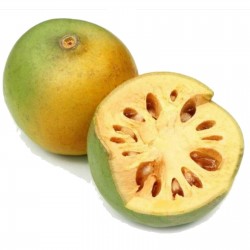
Bael Seeds - Bengal Quince,...
السعر
1.85 €
(SKU: V 93)
Seeds Gallery EU,
5/
5
<h2><span style="text-decoration:underline;"><em><strong>Bael Seeds - Bengal Quince, Stone Apple (Aegle marmelos)</strong></em></span></h2>
<h3><strong style="color:#ff0000;">Price for Package of 5 seeds.</strong></h3>
<div>Bael (Aegle marmelos), also known as Bengal quince, stone apple, wood apple, Bilva or Bilvapatra (మారేడు (maredu) (Telugu), வில்வம் (Tamil)) is a species of tree native to India. It is present throughout Southeast Asia as a naturalized species. The tree is considered to be sacred by Hindus. Its fruits are used in traditional medicine and as a food throughout its range.</div>
<p><strong>Botanical information </strong></p>
<p>Bael is the only member of the monotypic genus Aegle. It is a mid-sized, slender, aromatic, armed, gum-bearing tree growing up to 18 meters tall. It has a leaf with three leaflets.</p>
<p>Bael occurs in dry forests on hills and plains of northern, central and southern India, southern Nepal, Sri Lanka, Myanmar, Pakistan, Bangladesh, Vietnam, Laos, Cambodia and Thailand. It is cultivated throughout India, as well as in Sri Lanka, the northern Malay Peninsula, Java, the Philippines, and Fiji. It has a reputation in India for being able to grow in places that other trees cannot. It copes with a wide range of soil conditions (pH range 5-10), is tolerant of waterlogging and has an unusually wide temperature tolerance (from -7°C to 48°C). It requires a pronounced dry season to give fruit.</p>
<p>This tree is a larval foodplant for the following two Indian Swallowtail butterflies</p>
<p><strong>Fruit </strong></p>
<p>The bael fruit has a smooth, woody shell with a green, gray, or yellow peel. It takes about 11 months to ripen on the tree and can reach the size of a large grapefruit or pomelo, and some are even larger. The shell is so hard it must be cracked with a hammer or machete. The fibrous yellow pulp is very aromatic. It has been described as tasting of marmalade and smelling of roses. Numerous hairy seeds are encapsulated in a slimy mucilage.</p>
<p><strong>Uses </strong></p>
<p>The fruit is eaten fresh or dried. If fresh, the juice is strained and sweetened to make a drink similar to lemonade. It can be made into sharbat (Hindi) or Bela pana (Oriya: ବେଲ ପଣା) or bel pana (Bengali: বেল পানা), a refreshing drink made of the pulp with water, sugar, and lime juice, mixed, left to stand a few hours, strained, and put on ice. One large bael fruit may yield five or six liters of sharbat.</p>
<p> </p>
<p> </p>
<p>If the fruit is to be dried, it is usually sliced and sun-dried. The hard leathery slices are then simmered in water.</p>
<p>The leaves and small shoots are eaten as salad greens.</p>
<p>The Tamil Siddhars call the plant koovilam (கூவிளம்) and use the fragrant leaves for medicinal purposes, including dyspepsia and sinusitis.</p>
<p><strong>Medicinal Uses</strong></p>
<p>Research has found the essential oil of the Bael tree to be effective against 21 types of bacteria. It is prescribed for smooth bowel movement to patients suffering from constipation and other gastrointestinal problems.</p>
<p style="text-align:center;">Research also indicates that unripe Bael fruit is effective in combating giardia and rotavirus. While unripe Bael fruit did not show antimicrobial properties, it did inhibit bacteria adherence to and invasion of the gut (i.e. the ability to infect the gut).</p>
<p style="text-align:center;"> </p>
<table style="width:500px;float:left;" border="1" cellspacing="0" cellpadding="0"><tbody><tr><td colspan="2" valign="top" width="100%">
<p><span style="color:#008000;"><strong>Sowing Instructions</strong></span></p>
</td>
</tr><tr><td valign="top" nowrap="nowrap">
<p><span style="color:#008000;"><strong>Propagation:</strong></span></p>
</td>
<td valign="top">
<p><span style="color:#008000;">0</span></p>
</td>
</tr><tr><td valign="top" nowrap="nowrap">
<p><span style="color:#008000;"><strong>Pretreat:</strong></span></p>
</td>
<td valign="top">
<p><span style="color:#008000;">soak in water about 24 h</span></p>
</td>
</tr><tr><td valign="top" nowrap="nowrap">
<p><span style="color:#008000;"><strong>Stratification:</strong></span></p>
</td>
<td valign="top">
<p><span style="color:#008000;">0</span></p>
</td>
</tr><tr><td valign="top" nowrap="nowrap">
<p><span style="color:#008000;"><strong>Sowing Time:</strong></span></p>
</td>
<td valign="top">
<p><span style="color:#008000;">all year round</span></p>
</td>
</tr><tr><td valign="top" nowrap="nowrap">
<p><span style="color:#008000;"><strong>Sowing Depth:</strong></span></p>
</td>
<td valign="top">
<p><span style="color:#008000;">1 cm</span></p>
</td>
</tr><tr><td valign="top" nowrap="nowrap">
<p><span style="color:#008000;"><strong>Sowing Mix:</strong></span></p>
</td>
<td valign="top">
<p><span style="color:#008000;">Coir or sowing mix + sand or perlite</span></p>
</td>
</tr><tr><td valign="top" nowrap="nowrap">
<p><span style="color:#008000;"><strong>Germination temperature:</strong></span></p>
</td>
<td valign="top">
<p><span style="color:#008000;">18-25 ° C +</span></p>
</td>
</tr><tr><td valign="top" nowrap="nowrap">
<p><span style="color:#008000;"><strong>Location:</strong></span></p>
</td>
<td valign="top">
<p><span style="color:#008000;">bright + keep constantly moist not wet</span></p>
</td>
</tr><tr><td valign="top" nowrap="nowrap">
<p><span style="color:#008000;"><strong>Germination Time:</strong></span></p>
</td>
<td valign="top">
<p><span style="color:#008000;">about 2-6 weeks</span></p>
</td>
</tr><tr><td valign="top" nowrap="nowrap">
<p><span style="color:#008000;"><strong>Watering:</strong></span></p>
</td>
<td valign="top">
<p><span style="color:#008000;">Water regularly during the growing season</span></p>
</td>
</tr><tr><td style="text-align:center;" valign="top" nowrap="nowrap">
<p><span style="color:#008000;"><strong> </strong></span></p>
</td>
<td valign="top">
<p style="text-align:center;"><br /><span style="color:#008000;">Seeds Gallery 05.11.2012.</span></p>
</td>
</tr></tbody></table>
V 93

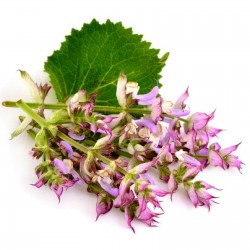
Clary Sage Seeds
السعر
1.95 €
(SKU: MHS 24)
Seeds Gallery EU,
5/
5
<h2><span style="text-decoration: underline;"><em><strong>Clary Sage Seeds Medicinal Plant (Salvia sclarea)</strong></em></span></h2>
<h3><span style="color: #ff0000;"><strong> Price for Package of 10 seeds.</strong></span></h3>
<div>Salvia sclarea, clary, or clary sage, is a biennial or short-lived herbaceous perennial in the genus Salvia. It is native to the northern Mediterranean, along with some areas in north Africa and Central Asia. The plant has a lengthy history as a medicinal herb, and is currently grown for its essential oil.</div>
<div>Description</div>
<div>S. sclarea reaches 3 to 4 ft (0.91 to 1.2 m) in height, with thick square stems that are covered in hairs. The leaves are approximately 1 ft (0.30 m) long at the base, .5 ft (0.15 m) long higher on the plant. The upper leaf surface is rugose, and covered with glandular hairs. The flowers are in verticils, with 2-6 flowers in each verticil, and are held in large colorful bracts that range in color from pale mauve to lilac or white to pink with a pink mark on the edge. The lilac or pale blue corolla is approximately 1 in (2.5 cm), with the lips held wide open. The cultivar S. sclarea 'Turkestanica' bears pink stems, petiolate leaves, and white, pink-flecked blossoms on spikes to 30 inches tall (75 cm).</div>
<div>History</div>
<div>Descriptions of medicinal use of the plant goes back to the writings of Theophrastus (4th century BCE), Dioscorides (1st century CE), and Pliny the Elder (1st century CE).</div>
<div>Uses</div>
<div>Clary seeds have a mucilaginous coat, which is why some old herbals recommended placing a seed into the eye of someone with a foreign object in it so that it could adhere to the object and make it easy to remove. This practice is noted by Nicholas Culpeper in his Complete Herbal (1653), who referred to the plant as "clear-eye".[3]</div>
<p>The distilled essential oil is used widely in perfumes and as a muscatel flavoring for vermouths, wines, and liqueurs.[1] It is also used in aromatherapy for relieving anxiety and fear, menstrual-related problems such as PMS and cramping, and helping with insomnia.</p>
<table style="width: 500px;" border="1" cellspacing="0" cellpadding="0">
<tbody>
<tr>
<td colspan="2" valign="top" width="100%">
<p align="center"><span style="color: #008000;"><strong>Sowing Instructions</strong></span></p>
</td>
</tr>
<tr>
<td valign="top" nowrap="nowrap">
<p align="center"><span style="color: #008000;"><strong>Propagation:</strong></span></p>
</td>
<td valign="top">
<p align="center"><span style="color: #008000;">Seeds</span></p>
</td>
</tr>
<tr>
<td valign="top" nowrap="nowrap">
<p align="center"><span style="color: #008000;"><strong>Pretreat:</strong></span></p>
</td>
<td valign="top">
<p align="center"><span style="color: #008000;">0</span></p>
</td>
</tr>
<tr>
<td valign="top" nowrap="nowrap">
<p align="center"><span style="color: #008000;"><strong>Stratification:</strong></span></p>
</td>
<td valign="top">
<p align="center"><span style="color: #008000;">0</span></p>
</td>
</tr>
<tr>
<td valign="top" nowrap="nowrap">
<p align="center"><span style="color: #008000;"><strong>Sowing Time:</strong></span></p>
</td>
<td valign="top">
<p align="center"><span style="color: #008000;">all year round</span></p>
</td>
</tr>
<tr>
<td valign="top" nowrap="nowrap">
<p align="center"><span style="color: #008000;"><strong>Sowing Depth:</strong></span></p>
</td>
<td valign="top">
<p align="center"><span style="color: #008000;">Cover lightly with substrate</span></p>
</td>
</tr>
<tr>
<td valign="top" nowrap="nowrap">
<p align="center"><span style="color: #008000;"><strong>Sowing Mix:</strong></span></p>
</td>
<td valign="top">
<p align="center"><span style="color: #008000;">Coir or sowing mix + sand or perlite</span></p>
</td>
</tr>
<tr>
<td valign="top" nowrap="nowrap">
<p align="center"><span style="color: #008000;"><strong>Germination temperature:</strong></span></p>
</td>
<td valign="top">
<p align="center"><span style="color: #008000;">15-20°C</span></p>
</td>
</tr>
<tr>
<td valign="top" nowrap="nowrap">
<p align="center"><span style="color: #008000;"><strong>Location:</strong></span></p>
</td>
<td valign="top">
<p align="center"><span style="color: #008000;">bright + keep constantly moist not wet</span></p>
</td>
</tr>
<tr>
<td valign="top" nowrap="nowrap">
<p align="center"><span style="color: #008000;"><strong>Germination Time:</strong></span></p>
</td>
<td valign="top">
<p align="center"><span style="color: #008000;">21 - 45 days</span></p>
</td>
</tr>
<tr>
<td valign="top" nowrap="nowrap">
<p align="center"><span style="color: #008000;"><strong>Watering:</strong></span></p>
</td>
<td valign="top">
<p align="center"><span style="color: #008000;">Water regularly during the growing season</span></p>
</td>
</tr>
<tr>
<td valign="top" nowrap="nowrap"><span style="color: #008000;"> </span></td>
<td valign="top">
<p align="center"><br /><span style="color: #008000;"> <em>Copyright © 2012 Seeds Gallery - Saatgut Galerie - Galerija semena. </em><em>All Rights Reserved.</em></span></p>
</td>
</tr>
</tbody>
</table>
MHS 24 (10 S)





